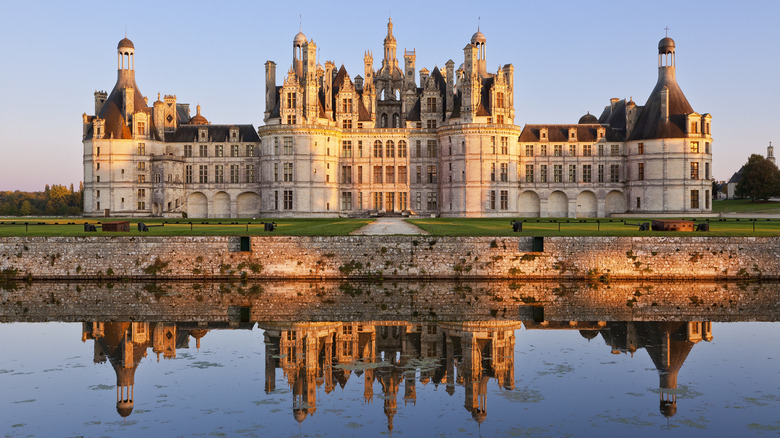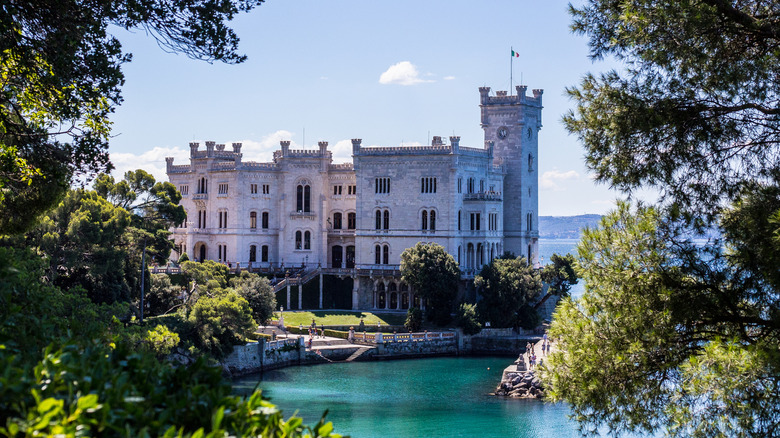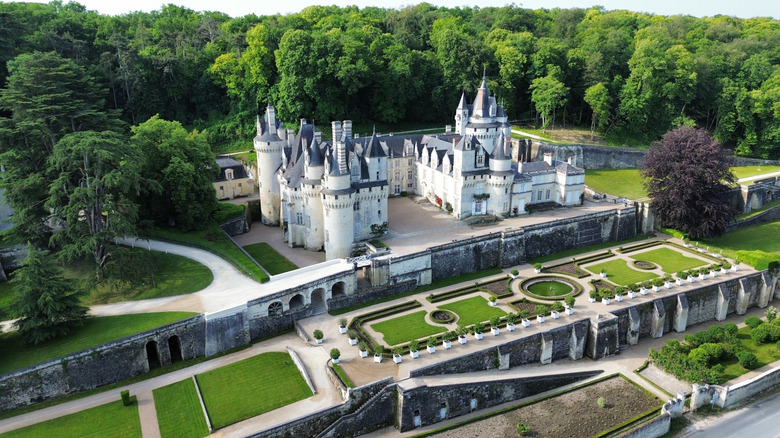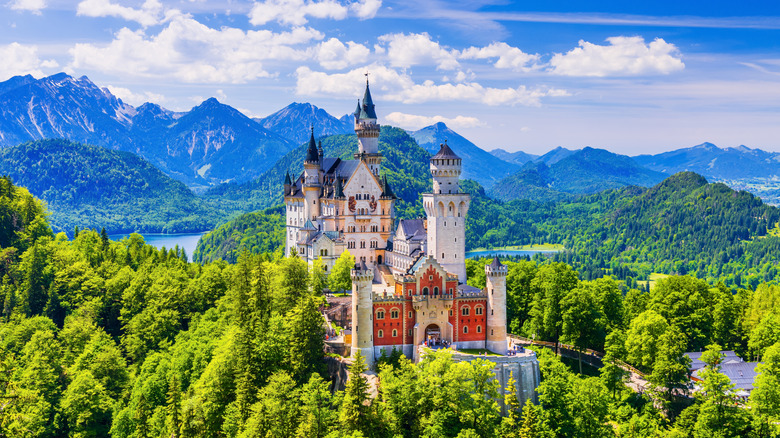The Most Fairytale-Like Hidden Castles In All Of Europe
Whether you're looking to live out a childhood dream, or you're simply an appreciator of history and architecture, Europe's fairytale castles have more than enough allure, beauty, and charm to offer visitors. From classic fortresses constructed to protect medieval kings, to regal chateaus serving as a royal summer home, there are thousands of castles scattered across Europe to choose from.
With that said, it can be difficult narrowing down which are most likely to transport you straight into a storybook, which is why we've selected the ones most worthwhile of your time. A number of these recommended castles are rightfully iconic, while others are more hidden and under the radar. A few even served as the direct inspiration for some of the most legendary castles of all — Disney's "Cinderella" and "Sleeping Beauty" castles. All were selected with the help of research, from plenty of travel blogs, travel publications, and tourism sites.
Alcázar of Segovia, Spain
Alcázar of Segovia is a picturesque castle just an hour or so outside of Madrid, with plenty of fairytale charm. In fact, it's even said to be one of Walt Disney's influences for none other than Cinderella's iconic castle. Built as a fortress in the early 12th century, and then serving as a royal palace for Alfonso VIII, Isabella and Ferdinand II, a prison, and then as a military academy before becoming a tourist attraction, Alcázar is an architectural and historic gem.
With a combination of Moorish and Christian architectural elements, decorated ceilings, and the Hall of the Kings — which features 52 statues depicting the kings who ruled from Alcázar –not to mention a beautiful view of the town below, this castle stuns visitors with its dramatic appearance. "This may be my favorite castle ever," said one past visitor on Tripadvisor. "Can I rate this on an '11'?!"
Neuschwanstein Castle, Germany
Neuschwanstein Castle is one of the most picture-perfect and legendary of all of Europe's castles, and it's just under two hours away from Munich. Perched on a hilltop with an otherworldly Bavarian Alps backdrop, this stunning castle is even said to be the inspiration for Disney's "Sleeping Beauty" and "Cinderella" castles — it doesn't get more fairytale-like than that.
Constructed in the 1800s for Ludwig II of Bavaria, the castle was opened to the public following his death. Keep in mind that photography or filming is not allowed inside the castle. Reaching the castle also involves walking uphill for 30 to 40 minutes — but visitors say the trek is more than worth it. You can also opt for a horse-drawn carriage, or a more efficient (but less romantic) shuttle bus ride — though the shuttle does still require a 10-15 minute walk. Visiting is currently only possible through a guided tour, and considering this castle's popularity, it's best to visit during a weekend day or offseason to avoid the crowds, and to purchase your ticket online in advance.
Pena Palace, Portugal
This hillside castle in Sintra, Portugal, has one of the most unique designs in all of Europe. Serving as a national monument and a UNESCO World Heritage Site, Pena Palace is a must for any architecture or history lover, or those looking for a destination full of storybook charm. "Fairy tales do come true," said one Tripadvisor reviewer. "Everywhere you look is beyond imagining."
Built in the mid-1800s for Ferdinand II, at the site of a former monastery, Pena Palace is colorful and incomparable, thanks to its romantic aesthetic, classic medieval features like lookout towers and a drawbridge, and Manueline (also known as Portuguese Gothic) and Moorish architecture. It is only made more dazzling thanks to its surrounding forests, which incorporate trees and plants from around the world, numerous winding paths, and gardens. Onsite, visitors can also pay a visit to the Chalet of the Countess of Edla, an Alpine-style building constructed for Ferdinand's second wife, opera singer Elise Friederike Hensler. Tickets purchased online at least three days in advance will be given a 15% discount.
Hohenwerfen Castle, Austria
Built on the site of a Roman castle, Austria's Hohenwerfen Castle began its long and varied life over 900 years ago. Throughout the centuries, Hohenwerfen Castle served as a palace and chapel, endured peasant revolts in the 16th century, transformed into a prison, a hunting base, a home, a Nazi military training base during World War II, and then a police school. Finally, in the '80s, it became a tourist attraction.
Today, visitors can experience Hohenwerfen Castle's breathtaking views from 2,000 feet above sea level. Visitors particularly love the birds of prey show held two or three times a day, and there's even an exhibition on witches and wizards, for those looking to embrace the fairytale theme. "Tripadvisor needs a rating higher than excellent for this castle," said one previous visitor. "The sight of this castle and the 360-degree view of the Alps ... stuck in my head for 19 years."
Peleş Castle, Romania
A visit to Romania's Peleş Castle is "like stepping into a fairytale," said one Tripadvisor reviewer. Hidden away in the small town Sinaia, and located at the base of a mountain, Peleş Castle is full of history and whimsical storybook charm. First commissioned by Romania's first king in the 1800s, it took 40 years for Peleş Castle to come to life. Notably, it was the first castle in Europe to utilize locally produced energy, using an electric system as early as 1884 and introducing a central heating system 13 years later.
Of its 160 rooms, the Great Armory Room is particularly spectacular, with more than 4,000 pieces of weaponry, as is the Royal Library thanks to its gold-decorated manuscripts. The interior throughout is impressive though, with wood carvings and stained glass. "Going there was one of the best experiences of my life to this day," said one Redditor.
Château de Chambord, France
It doesn't get much more regal than the Château de Chambord. This 16th-century castle, located in a forested park in the Loire Valley, looks straight out of a fairytale thanks to its courtyards, decadent design, and French Renaissance architecture. Initially built as a hunting retreat for Francois I, Château de Chambord is one of the most expensive building projects led by a French monarch, which isn't surprising to those who have visited.
This massive palace has 426 rooms, 282 fireplaces, and 77 staircases, including a famous double-helix staircase that may have been designed by none other than Leonardo da Vinci. Due to this chateau's impressive size, plan to spend at least a couple hours here, wandering through the many rooms and gardens. "This castle is absolutely stunning, and is worth a look," said one Tripadvisor reviewer. "It is every bit the fairytale and is even more breathtaking in real life than in the photos."
Conwy Castle, Wales
Conwy Castle is a breathtaking medieval fortress dating all the way back to the 13th century. Built by King Edward I on a rocky hill, overlooking both a river and the town of Conwy, this castle offers jaw-dropping mountain and valley views. And as a particularly well-preserved fortress with a rich history spanning centuries, it also gives visitors a unique look into medieval life. The castle served as a site for historical events like a Welsh rebellion against the English, and the Welsh Civil War.
Visitors can explore the castle's many nooks and crannies, see royal chambers, and climb the towers for sweeping views. "Conwy Castle is one of the most magnificent fortresses in Europe, which still towers over the town of Conwy after 700 years," said one previous visitor on Tripadvisor. "Highly recommend to dive into the old days of Wales taking an exciting walk within the walls of Conwy Castle."
Kadriorg Palace, Estonia
This striking palace in Tallinn, Estonia, was originally commissioned by Peter the Great in the 1700s as a summer residence (the name Kadriorg was given in honor of his wife, Catherine I), and serves as a stunning example of Baroque architecture in Northern Europe. The multi-colored palace has distinctive architecture and features, from frescoed ceilings to stucco ornamentation. Outside, find gorgeous gardens, fountains, and flowers, inspired by the gardens of France's iconic Versailles palace.
Today, Kadriorg Palace serves as an art museum, where spectators can view a collection of Western European and Russian art. "This castle is enchanting and offers beauty both indoors and outdoors," said one visitor on Tripadvisor. "It must be seen!"
Castello di Miramare, Italy
Italy has over 45,000 castles, towers and villas, but Castello di Miramare, just outside Trieste,is without a doubt one of its most charming. Overlooking the sea and situated in a historic park, full of manicured gardens and rare types of trees, the view makes this 19th-century castle particularly picturesque. Visitors can also explore romantic English- and Italian-style gardens, which notably includes a daffodil garden.
The castle itself, initially built for Archduke Ferdinand Maximilian of Habsburg, is also more than worth a visit, offering a look into the lives of royalty, from the private royal rooms to the throne room. One wing is also home to the Immersive Museum of the Protected Marine Area of Miramare. "Such an amazing place," recalled one past visitor on Tripadvisor. "It has an incredible history, is in a beautiful setting, and the gardens are magnificent."
Bled Castle, Slovenia
Slovenia's emerald-toned Lake Bled is home to a natural island that looks straight out of a medieval fairytale, but one of its most special features is Bled Castle perched on the island. Its lush surrounding forests and amazing views add to its magical appearance, but it also has a history stretching back 1,000 years. Its story begins back in 1004, when it was a singular tower. The first castle was then built in 1011, with initial towers and fortification systems added throughout the Middle Ages.
Visitors can experience the 16th-century castle chapel, view frescoes and stone engravings, visit a museum focused on Lake Bled, explore the Bled Castle Printing Works and the castle wine cellar, and much more, all while taking in Bled Castle's awe-inspiring views. There's much to love for those interested in history, but for those that aren't, past visitors say that the views alone make the uphill climb more than worth it. Just take it from one past Tripadvisor reviewer: "Must visit when visiting Slovenia – PERIOD."
Ussé Castle, France
Ussé Castle is said to have inspired Charles Perrault when he wrote "Sleeping Beauty," and this castle truly embraces its enchanting qualities. Those who tour Ussé will find scenes from "Sleeping Beauty" depicted throughout, with wax statues and decor. Initially built in the Middle Ages, over time Ussé Castle evolved into one of Europe's best examples of Renaissance architecture. In the 17th century, it became a residential palace.
Today, it is still the residential home for the Duke of Blacas — meaning that certain areas are off limits during visits. However, visitors can still explore a number of locations throughout the castle, including the garden, the guard room, the dining room, the king's chamber, and even a dungeon. "A stunning château from first sight, you can understand why it was the inspiration for Sleeping Beauty," said one past visitor on Tripadvisor. "The best historic property visit I have ever experienced."
Bran Castle, Romania
While not the inspiration for a fairytale, per se, Bran Castle in Romania is said to have been the inspiration for Bram Stoker's "Dracula," cementing its own magical, literary influence. Bran Castle, located just a few hours outside Bucharest– which is often called the "Little Paris Of The East" – has a history dating back to the early 1200s. Construction of the overall castle was completed in 1388, and although it was the site of numerous events throughout Romania's history, today it is most closely associated with none other than Count Dracula himself.
Despite its spookier associations, Bran Castle is also remarkably beautiful. With gorgeous mountain landscapes and its hilltop location, Bran Castle offers remarkable views of the forest below."If you like historical places and just taking in the atmosphere then this is the place," said one past visitor on Tripadvisor. "The views from below, looking up at the castle are awesome and stunning." Just keep in mind that this destination can get crowded, so it's best to visit during spring or fall, and avoid weekends.
Frederiksborg Castle, Denmark
It doesn't get much more regal than Frederiksborg Castle. Under an hour or so outside of Copenhagen by train, Frederiksborg Castle is situated on three small islands surrounded by a lake, making it particularly majestic. Dating back to the 17th century, this castle is distinguished by its extensive gardens and Renaissance architecture. As Scandinavia's largest Renaissance castle, Frederiksborg is certainly impressive, with features including its Neptune Fountain, Marble Gallery, baroque style garden, and decadent chapel, still sometimes used by Denmark's royal family.
Notably, it's also the site of the Danish Museum of National History, which it has housed since the 1800s. Past visitors advise spending at least three hours to really take in all of the grandeur and history that Frederiksborg has to offer. "It's an amazing castle where you can discover a lot of stories, see beautiful rooms and get a feeling how the kings lived," said one previous visitor. Tickets can be purchased online to be used within three months.
Bojnice Castle, Slovakia
This romantic 12th-century castle in Slovakia, with turquoise tower tops, is located on a hill overlooking a forest, lake, and royal gardens, ensuring truly magical views. One of Slovakia's oldest and most important monuments, Bojnice Castle is a treasure trove of history. Occupied by numerous royal figures who had a hand in shaping Bojnice's style, the castle is now made up of a distinctive blend of Baroque, Gothic, and Renaissance elements.
Bojnice Castle was first opened to the public in 1907. The picturesque castle's historic chapel, the knight's hall, and library are all worth a visit. Bojnice Castle even has its own natural travertine cave, which is also open to the public.
Edinburgh Castle, Scotland
A visit to Edinburgh Castle is a must for any travelers in Scotland. One of the world's most iconic medieval castles, Edinburgh Castle sits atop a volcanic rock in Scotland. Over the centuries, this castle has served as a royal residence, a military post, a prison, and a fortress, housing legendary historical figures from Queen Margaret (who died in the castle in 1093 before being named a saint) to Mary Queen of Scots.
While at Edinburgh Castle, plan to spend at least a couple of hours to ensure you have enough time to explore highlights — like St. Margaret's Chapel, built around 1130, the Great Hall, built around 1510, and out-of-this-world panoramic views of Edinburgh. The often-overlooked National War Museum of Scotland is also housed here. Plus, the UNESCO World Heritage Site is notably home to Scotland's crown jewels. Due to this castle's popularity, it's recommended that you purchase your tickets in advance.
Eltz Castle, Germany
While it's true that Europe is full of picture-perfect castles, Eltz Castle in Germany is truly a mystical gem with rare features that make it stand out from the rest. This is largely due to its picturesque location in the Moselle Valley, surrounded by forests and a nearby river. "This is really a princess castle (from) a movie!" said one prior visitor on Tripadvisor. Eltz Castle does seem to be straight out of a storybook, with a gorgeous blend of Romanesque, Gothic, and Renaissance styles, multiple towers, decorative stonework, and more.
Throughout Eltz Castle's 900 years of history, it somehow managed to never be destroyed or captured, meaning it appears shockingly well preserved. Plan to spend at least three hours exploring the architecture, artwork, and extensive collection of artifacts throughout the castle, which have been in the Eltz family for 34 generations — over 850 years.
Methodology
With thousands of castles scattered across Europe, narrowing them down for this list involved relying on plenty of sources like travel blogs, travel publications, and tourism sites. A range of countries were intentionally represented, and each selected castle was then thoroughly researched to ensure that it is indeed worth visiting and lives up to its fairytale reputation.

















